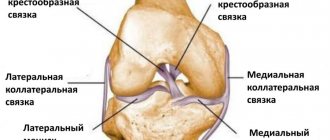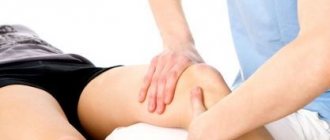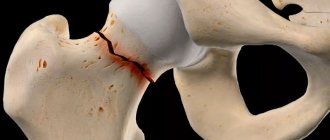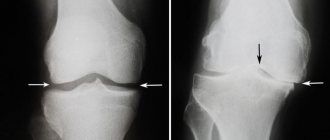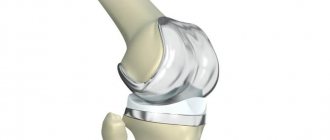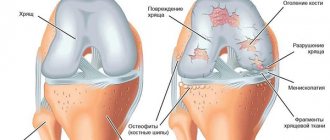Arthrosis of the knee joint grade 4 does not exist in the medical classification. This term refers to gonarthrosis of the 4th radiological stage. The images obtained during the diagnostic study clearly visualize the complete fusion of the joint space of the knee. The disease is characterized by damage to hyaline cartilage, which covers the surfaces of the bones that form the joint. The leading symptom of arthrosis of the knee joint is immobilization of the limb (ankylosis).
Ankylosis of the right knee (pictured on the left).
With bilateral gonarthrosis, a person loses the ability to move. To diagnose arthrosis, radiography is performed, and, if necessary, MRI, CT, and arthroscopy. Conservative treatment methods are not used in the treatment of a disease of such high severity. Patients are indicated for joint replacement with an endoprosthesis. Other types of surgical interventions are also practiced.
The mechanism of pathology development
The knee joint is formed by the femur and tibia, the surfaces of which are covered with cartilage. It is durable, smooth, tightly elastic. In a person with normal health, when moving, the structural elements of the knee move relative to each other without effort. Smooth gliding is ensured by synovial fluid, which has shock absorber properties. Under the influence of one of the negative factors, blood circulation in the joint is disrupted. A deficiency of molecular oxygen, nutrients and biologically active substances occurs in tissues. Deterioration of blood supply leads to pathological changes in hyaline cartilage:
- its surface becomes dry, rough;
- When sliding, small and then large particles begin to separate.
The synovial fluid thickens and loses its shock-absorbing properties. To compensate for the load on the knee, bone tissue grows in the joint cavity and osteophytes form.
With arthrosis of 3 (4 x-ray) degree, the hyaline cartilage is completely destroyed. The situation is worsened by severe bone deformation. They bend, pressing into each other, making any movement in the knee impossible.
Symptoms
As already mentioned, pain in grade 4 arthrosis worries the patient constantly. If in the first stages of the disease they are weak and periodic, then in grade 4 they are very intense, and can occur not only after prolonged stress on the knee (walking or lifting weights), but also at rest.
The deformity of the knee is clearly visible, and the deformation of the bone is also clearly visible. Patients with stage 4 arthrosis of the knee joint move on bent legs - the knee remains motionless. Fluid accumulates in the joint, and an elastic seal forms on the back wall of the joint.
Causes and provoking factors
Arthrosis of the knee joint of 4 degrees can be primary and secondary. This classification allows you to outline a treatment plan and avoid destructive-degenerative damage to other joints of the musculoskeletal system.
The causes of primary gonarthrosis have not yet been established. Scientists only have guesses as to why the disease affects this particular patient. The impetus for the development of the pathological process is the natural aging of the body. The production of collagen, the building material of ligaments and tendons, decreases. They lose their firmness, elasticity, and stretch, which leads to a decrease in their functional activity. There are versions that premature destruction of the joint is provoked by diseases occurring against the background of metabolic disorders or circulatory disorders. The causes of secondary arthrosis are well known:
- chronic joint diseases - rheumatoid, psoriatic, juvenile arthritis, osteoarthritis, gout. Moreover, the pathology is not necessarily localized specifically in the knee. The destruction of any joint leads to a redistribution of loads in the musculoskeletal system, so secondary arthrosis can develop in any joint;
- excessive loads. In the United States, the most popular operation in clinics is knee replacement. Doctors attribute this to Americans' great passion for running. At a young age, you don’t have to worry about the condition of your knees when playing sports. But after 40 years, you should approach physical activity wisely, reduce the number and duration of training;
- injuries - fractures, ligament and tendon ruptures, dislocations, severe bruises. It is injury that causes the diagnosis of grade 3 arthrosis in young people. Even after proper treatment, scars can form in the joint structures, impairing the functioning of the knee. Gradually this leads to the development of destructive and degenerative changes in tissues.
Excessive stress on the joint occurs with obesity. The vast majority of overweight people suffer from knee pain caused by low-grade inflammation or degenerative changes in the cartilage.
Some characteristics of the body that are genetically transmitted from parents can lead to complete immobility of the lower part of the body. This is a certain structure of hyaline cartilage, blood supply deteriorating over time, and metabolic disorders.
Causes of pathology
A large number of factors contribute to the development of pathology. In extremely rare cases, only one cause is identified - much more often the pathology is provoked by a complex of factors:
- Excessive mechanical stress on the joint. This can be observed in overweight people engaged in heavy physical work, especially those associated with long periods of standing. Risk factors include improper weight distribution due to scoliosis.
- Violation of the integrity of parts of the joint due to injury, osteoporosis and osteomyelitis.
- Sedentary lifestyle. Lack of normal physical activity leads to the fact that the periarticular muscles atrophy, the blood supply to the joint deteriorates, which prevents it from withstanding simple loads.
- Vascular diseases (atherosclerosis). This cause is more often found in elderly and/or smoking patients.
- Congenital pathology of joint development.
- Violation of metabolic processes. This prevents sufficient minerals from reaching the joint tissues. This is often observed in the hip region.
- A large amount of stress, emotional turmoil.
- Weakness of the ligamentous apparatus.
Arthrosis of the knee of the fourth stage is caused by ignoring the first alarm bells and, accordingly, a late start of treatment.
Clinical picture
Arthrosis of the 4th degree of the knee joint is most often diagnosed in patients who did not receive adequate treatment for the pathology in the initial stages. Over time, the pain intensified, and the joint lost mobility. Its configuration changed: the joint became larger compared to a healthy knee. Knee pain with arthrosis of the 3rd degree becomes constant. They get worse when trying to bend the knee and do not subside at night. There are several clinical manifestations characteristic of the last stage of pathology:
- to fall asleep, a person has to look for a comfortable body position for a long time;
- During the day, but more often at night, the patient is bothered by convulsive muscle contractions;
- when trying to bend or straighten the knee, a sharp, piercing pain occurs;
- the legs become bent and take on an X- or O-shape;
- the gait changes: the person waddles and has a strong limp.
Exposed joint.
With arthrosis, crunching and clicking sounds are clearly heard when moving, bending or straightening the knee. This condition is medically called crepitus. Complete fusion of the joint space leads to complete immobilization of the joint. If it ossifies in a bent position, then with unilateral gonarthrosis the person moves only with the help of crutches. The development of bilateral arthrosis is the cause of complete immobility of a person. Ossification of the knee in an extended position is more favorable. The patient moves more confidently and even leans on the injured leg.
Arthrosis of the 4th degree is often accompanied by synovitis. This disease is characterized by pathological accumulation of fluid in the joint and the development of an inflammatory process. Exudate is often infected with pathogenic bacteria, which leads to accelerated destruction of the joint. The main symptom of synovitis is the formation of a lump in the knee area. The pathology also provokes general intoxication of the body, which occurs against the background of an increase in body temperature.
Diagnostics
The initial diagnosis is established by external examination of the patient and not on the basis of characteristic clinical manifestations. In addition to deformation of the limbs, studying the anamnesis helps to establish grade 4 arthritis. To confirm the diagnosis, an X-ray examination is performed - a classic method for identifying any disease of the musculoskeletal system. The photographs taken in two projections show the following signs of gonarthrosis:
- complete or partial fusion of the joint gap, change in its contours;
- the presence of calcified areas in the remaining hyaline tissues;
- proliferation of bone tissue;
- presence of crystals;
- thinning of bones, decrease in their density.
The patient is shown laboratory tests of blood and urine. The erythrocyte sedimentation rate, fibrinogen and urea levels are determined. Test results help assess the patient’s general health and the exacerbation of other chronic pathologies.
If the X-ray images have little information, computed tomography or magnetic resonance imaging is performed to determine the extent of damage to the connective tissue structures of the knee - soft tissues, ligaments and tendons.
Treatment methods
Treatment for grade 4 arthrosis of the knee joint involves surgery. Conservative methods of therapy are not used. Firstly, there are no drugs that can restore destroyed cartilage tissue. Secondly, the bones of the joint are so deformed that movement becomes impossible. The patient is prescribed a course of medications:
- non-steroidal anti-inflammatory drugs or glucocorticosteroids to reduce pain and swelling;
- chondroprotectors to prevent further destruction of joint and bone tissues.
And the mobility of the joint can only be restored through surgery. After diagnosing grade 4 arthrosis, endoprosthetics is performed. The knee joint is completely replaced with a prosthesis made of metal, ceramics or polymer materials. The service life of the endoprosthesis is 20 years. This operation restores mobility to a person and avoids disability.
| Surgical operations indicated for grade 4 arthrosis of the knee joint | Description of the surgical method |
| Periarticular osteotomy | The bones of the joint are filed down and secured in an anatomically correct position. |
| Arthroscopic debridement | The joint is freed from deformed cartilage tissue to facilitate the main operation |
| Arthrodesis | The joint is fixed in a stationary state, artificial ankylosis is created |
If an orthopedist insists on endoprosthetics, then you should trust his experience and not use alternative treatment methods. In some cases, this surgical operation is performed even with arthrosis of the 2nd degree. There is a risk of prosthesis rejection, but this situation occurs extremely rarely. You should not drown out the pain with pills or use folk remedies. Seeking medical help will help you lead an active lifestyle and remain productive for many years.
Diagnosis and treatment tactics for arthrosis
Arthrosis that has reached grade 4 is detected during the initial examination of the patient and analysis of complaints. X-rays are performed to confirm the diagnosis. A blood test is prescribed, but with arthrosis, as a rule, the main indicators remain unchanged.
If a patient is diagnosed with arthrosis of the fourth degree, all treatment methods are reduced to medication and surgery. Physiotherapy provides a rather supportive effect - it is designed to maintain the results achieved while taking medications and/or undergoing surgery to replace the knee joint.
Medicines
For diagnosed arthrosis of the fourth degree, drug therapy consists of prescribing strong analgesics. Most patients suffer from pain, but conventional painkillers do not relieve it. This forces doctors to prescribe narcotic analgesics.
Most of the drug therapy is preparation for the upcoming surgical intervention - the only effective option for solving the problem of arthrosis of the fourth degree. In particular, to reduce the risk of developing an inflammatory process, corticosteroids are prescribed.
Maintenance therapy
To stabilize the condition, patients are prescribed:
- ozone therapy;
- kinesitherapy;
- taking dietary supplements;
- treatment with homeopathic remedies.
Ozone therapy is the effect of ozone on the affected area. The drug is administered intravenously. The method has no contraindications. The great analgesic and anti-inflammatory effect is the reason why ozone therapy is recommended for patients with fourth degree arthrosis of the knee joint.
Important! Kinesitherapy or special gymnastics is carried out only by a specialist who calculates the individual dosage of the effect on the inflamed joint. Gymnastics is performed exclusively under the supervision of a doctor!
Surgical intervention
Grade 4 arthrosis of the knee joint is accompanied by a strong degree of tissue degradation. The most effective way to restore mobility to a joint is endoprosthetics. The essence of the procedure is to replace the entire affected joint or only part of it. The removed area is replaced with a prosthesis made of medical metal.
Despite the high level of technology, the implanted artificial joint still needs to be replaced, but only twenty years after surgery. Such a long service life allows the prosthesis to be used in patients of different ages.
The surgery takes about three hours. The patient is given general anesthesia. After installation of the implant, a hospital stay is recommended.
Before the intervention, the patient undergoes a comprehensive examination of several patients:
- cardiologist;
- urologist;
- endocrinologist
Any inflammation in the body detected during the examination must be treated before surgery.

